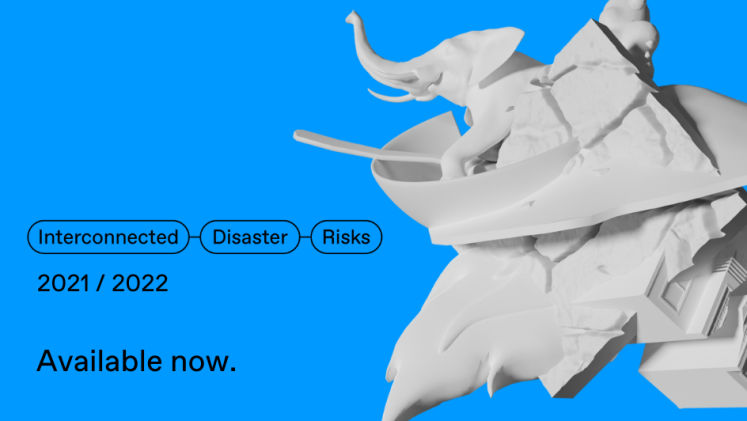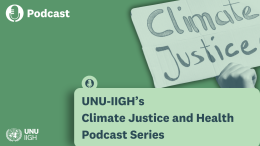Bonn, Germany 31 August – After a summer of climatic extremes across the world, a new United Nations University report looks at how the right solutions can reduce the risk of such hazards turning into full-blown disasters, or in some cases eliminate them altogether. After a summer of climatic extremes across the world, a new United Nations University report looks at how the right solutions can reduce the risk of such hazards turning into full-blown disasters, or in some cases eliminate them altogether.
As climate change continues to accelerate and its impacts are increasingly felt, the challenges for disaster risk reduction in the future will only grow and be intensified by the impacts of nature and biodiversity loss. Solutions are already being implemented around the world to address risks, but interconnectivity is not yet placed at the heart of solution design and implementation.
“Interconnected Disaster Risks Report 2021/2022” by the United Nations University - Institute for Environment and Human Security (UNU-EHS) analysed 10 disasters from around the world, which were selected to be representative of a larger global issue, to identify shared root causes and drivers of disasters, and came up with eight solutions which can prevent or reduce a number of disaster risks:
- Let nature work (coexist with natural processes)
- Innovate (using new ideas)
- Work together (enhancing collaboration)
- Secure livelihoods (establish safety nets to protect people)
- Consume sustainably (modify our consumption patterns)
- Strengthen governance (increasing capacity of institutions)
- Plan for risks (being risk-aware in designing and building infrastructure)
- Boost early warning (enhancing our capacity to predict and communicate risks)
In the past year alone, disasters caused the loss of around 10,000 human lives and over $280 billion in damages worldwide.
“The good news is that just as the disasters are interconnected, so are the solutions,” stated Dr. Jack O’Connor, Senior Scientist at UNU-EHS and Lead Author of the Interconnected Disaster Risks report. “One type of solution can prevent or reduce a number of different disaster risks, and through our research we were able to identify solutions which can prevent or drastically reduce the impacts of disasters to help us save lives and avoid costly damages.”
Launched two months ahead of the UN Climate Conference (COP27) in Sharm el-Sheikh, Egypt, the report demonstrates that by looking below the surface and identifying the drivers that cause disasters to develop, such as deforestation or urbanization, we can decrease the risk of disasters before they occur. For example, deforestation leads to soil erosion, where a lack of trees and roots means that there is no protection from wind and rain and the soil is easily washed or blown away. This creates ideal conditions for multiple disasters, such as the devastating landslides during the Haiti earthquake, the formation of sandstorms in southern Madagascar and the sedimentation of water reservoirs contributing to the Taiwan drought, leading to lives lost or people’s homes and income opportunities being destroyed. By applying the solution “Let nature work”, we can harness nature’s processes to reduce hazards; for example, by restoring forests to stabilize the soil and prevent land degradation.
The solutions identified in the report are most powerful when implemented in “solution packages”, where multiple solutions work together to address the different elements of each interconnected disaster. For example, a solution package to address the looming extinction of the vaquita is to work together with local fisher communities to co-manage conservation areas, to innovate and implement more sustainable fishing methods, to raise awareness for sustainable consumption and to enforce regulations to prevent harmful overfishing and illegal trade. This solution package has a better chance of addressing the problem than if any of the solutions are implemented in isolation.
“The research on this is clear. Without investing and scaling up smart solutions, the disasters of 2021/2022 are just the beginning of a new normal. The responsibility to make changes rests with all parts of society: the private sector, governments, regional and local decision makers, but also with us as individuals. All of our actions have consequences for all of us. In an interconnected world, we are all part of the solution,” concluded Dr. Zita Sebesvari, Deputy Director of UNU-EHS and Lead Author of the Interconnected Disaster Risks report.
###
Notes to Editors
High-resolution photography and B-roll are available upon request.
Press release in English, German, Spanish, available.
For more information or to arrange an interview, please contact:
Janine Kandel
Head of Communication
United Nations University Institute for Environment and Human Security
Phone: + 49 151 2672 1390 (mobile)
press@ehs.unu.edu
www.ehs.unu.edu
Austin Gonzales
Communications Assistant
United Nations University Institute for Environment and Human Security
Phone: + 49 228 815 0276
gonzales@vie.unu.edu
www.ehs.unu.edu
Images for report coverage are also available here: https://bit.ly/IDDR22Pics
About the Interconnected Disaster Risks Report (#InterconnectedRisks)
Interconnected Disaster Risks is an annual science-based report for the general public from the United Nations University – Institute for Environment and Human Security, first published in 2021. Recognizing that disasters are occurring at an ever faster rate and, despite progress being made in how we prepare and respond to them, we are continuously being caught-out by new extremes and new emerging threats. The report analyses ten disasters each year and analyses how they are interconnected with each other and with human actions. It seeks to explain the interconnections that might otherwise be missed, and describes how we can develop solutions to use these connections to our advantage. At the same time, the report is based on thorough scientific analysis and includes technical background reports for each of the ten disasters which together with the main report and executive summary are made available on interconnectedrisks.org
About the United Nations University, Institute for Environment and Human Security (UNU-EHS)
Based in Bonn, Germany, UNU-EHS conducts research on risks and adaptation related to environmental hazards and global change. The institute’s research promotes policies and programmes to reduce these risks, while taking into account the interplay between environmental and societal factors. Research areas include climate change adaptation by incorporating insurance-related approaches, environmentally-induced migration and social vulnerability, ecosystem-based solutions to adaptation and disaster risk reduction, and models and tools to analyse vulnerability and risks linked to natural hazards, with a focus on urban space and rural-urban interfaces. UNU-EHS also offers the joint Master of Science degree programme “Geography of Environmental Risks and Human Security” with the University of Bonn and hosts international PhD projects and courses on global issues of environmental risks and sustainable development. Follow us on Twitter @UNUEHS and visit ehs.unu.edu



